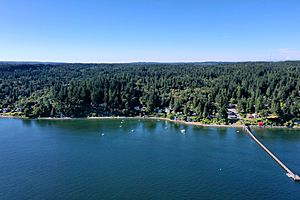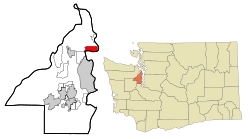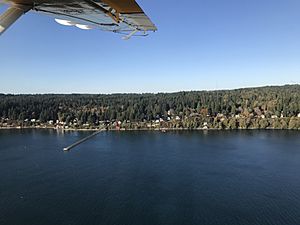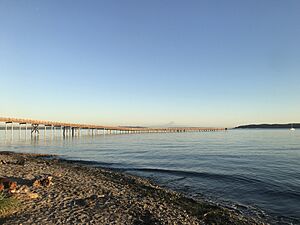Indianola, Washington facts for kids
Quick facts for kids
Indianola, Washington
|
|
|---|---|
 |
|
| Nickname(s):
"Ola"
|
|

Location of Indianola, Washington
|
|
| Country | United States |
| State | Washington |
| County | Kitsap |
| Area | |
| • Total | 5.3 sq mi (13.8 km2) |
| • Land | 4.9 sq mi (12.6 km2) |
| • Water | 0.5 sq mi (1.2 km2) |
| Elevation | 43 ft (13 m) |
| Population
(2020)
|
|
| • Total | 3,664 |
| • Density | 623.6/sq mi (240.8/km2) |
| Time zone | UTC-8 (Pacific (PST)) |
| • Summer (DST) | UTC-7 (PDT) |
| ZIP code |
98342
|
| Area code(s) | 360 |
| FIPS code | 53-33280 |
| GNIS feature ID | 1533572 |
| Historical population | |||
|---|---|---|---|
| Census | Pop. | %± | |
| 2010 | 3,500 | — | |
| 2020 | 3,664 | 4.7% | |
| Sources: | |||
Indianola is a small community in Kitsap County, Washington. It is located on the northern shore of Port Madison. This area is part of the Port Madison Indian Reservation, which is home to the Suquamish Indian Tribe.
In 2020, about 3,664 people lived in Indianola. It started as a place where people would go for summer vacations. For many years, it was a stop for the "Mosquito Fleet" ferries. These ferries were like water taxis that carried people around Puget Sound until the 1950s.
Contents
Geography of Indianola
Indianola is found at 47.751512 degrees north and -122.522878 degrees west. It sits on the north side of Port Madison. This location is just east of Miller Bay.
The community is south of Kingston. It is also northeast of Suquamish. The total area of Indianola is about 5.3 square miles (13.8 square kilometers). Most of this area, 4.8 square miles (12.6 square kilometers), is land. The rest, about 0.5 square miles (1.2 square kilometers), is water.
History of Indianola
Early Beginnings
Indianola began on land that was part of the Port Madison Indian Reservation. This land was given to a person named KaKue in 1886. After KaKue and his wife passed away, the land eventually went to their family members.
Later, the land was passed to the sons of Alpheus Loughrey. Alpheus was a white man who had married Katie, a daughter of KaKue's wife.
Developing a Community
In 1916, a company called Indianola Beach Land Company started to sell land here. They wanted to create a new community. To attract buyers, they built a dock and a store. Another store, called the Beachcomber, opened the next year.
From the very beginning, Indianola was a popular vacation spot. Its population grew a lot during the summer months.
Transportation and Growth
In the early 1900s, most travel on Puget Sound was by steamboat. A town's dock was its main way to connect with the outside world. This was true for Indianola Beach. By 1918, a steamboat stopped there every weekend.
Daily ferry service to Seattle started in 1919. A man named Carl Hendrix organized 12 passengers to pay for a year of daily service. Hendrix and his wife also started a school that same year.
Post Office and Name Change
Cyrus Beede Pickrell, who worked as an Indian Agent for the Port Madison Reservation, moved to Indianola Beach in 1920. The postal service had stopped, so the Pickrells opened a new store. They also housed the post office there, with Cyrus as the Postmaster.
Around this time, the Postmaster General decided that "Indianola Beach" was too long. So, the post office was renamed "Kitsap." This name honored Chief Kitsap of the Suquamish tribe.
Building the Clubhouse
The 1920s were a busy time for Indianola. People planned to build a library and a community hall. They held auctions and a carnival in 1927 to raise money. The Indianola Beach Improvement Club was formed in 1928 to help raise more funds.
The club bought some land and raffled it off. The money raised helped them buy property for the new building. The Indianola Clubhouse was finally built in 1930.
New Connections
By 1929, three passenger boats left the Indianola dock for Seattle every day. The 1930s brought even more connections to the outside world. Electricity came to Indianola in 1930. Phone service was set up in 1934.
The Port of Indianola was created in 1933. The dock, which was only for people, was made wider and stronger for cars. In 1935, Kitsap County started planning a road to connect Indianola and Suquamish. This road was finished in 1939. It was the first time Indianola could be reached by car, not just by boat.
Changes and Modern Times
Having a road changed Indianola quite a bit. People could now easily get to other places in Kitsap County. This meant the community didn't have to be as self-contained. The school closed in 1941 after more than 20 years.
During World War II, many families moved to Indianola. This was because Kitsap County had many naval bases. Ferry service stopped in 1951. This happened after the Agate Pass Bridge opened, making it easier to drive.
It wasn't until after 1957 that the post office name changed from Kitsap back to Indianola. This was done to avoid confusion, as "Kitsap" was also the name of the county.
Population and Community
As of the 2020 census, Indianola had a population of 3,664 people. The community is made up of many families and individuals. About 29.6% of the population is under 18 years old.
The community has a mix of different people. Many households are families living together. Indianola is a place where people enjoy living near the water and being part of a close-knit community.
 |
Port Gamble | Kingston | Puget Sound |  |
| Poulsbo | Puget Sound | |||
| Suquamish | Port Madison, Bainbridge Island | Puget Sound |
See also
 In Spanish: Indianola (Washington) para niños
In Spanish: Indianola (Washington) para niños



